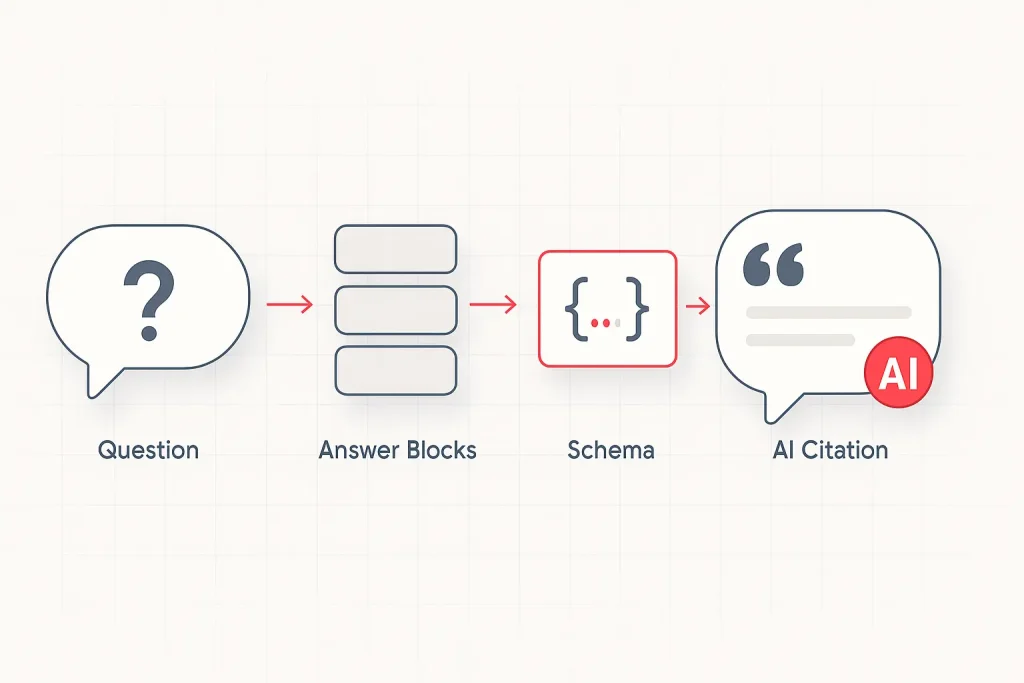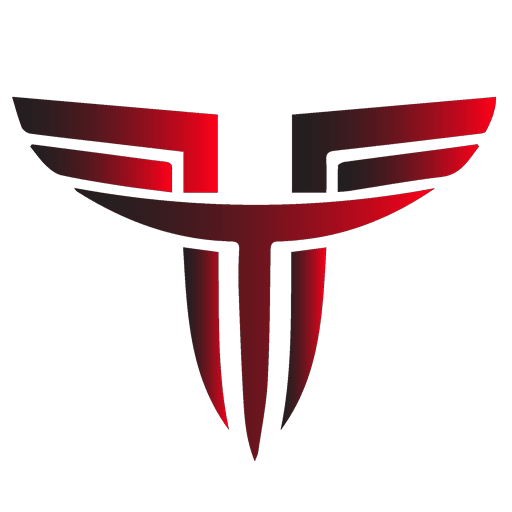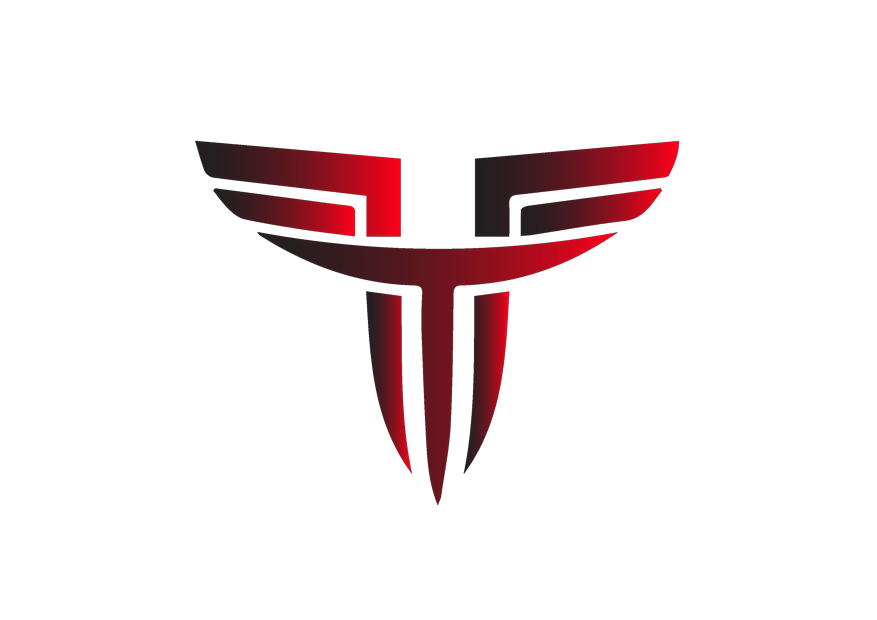If your brand is not the answer, your funnel is someone else’s.

What is answer engine optimization and why it matters now
Answer engine optimization means structuring content for extraction, adding schema to clarify meaning, and earning enough authority that AI chooses your words when it speaks.
Answer engine optimization is the practice of shaping your content so AI systems can find it, understand it, and quote it with confidence. It is different from classic SEO, yet it builds on the same fundamentals. Today, buyers ask AI tools direct questions, and those tools return direct answers. Therefore, visibility now lives inside answers, not only on results pages. When your definition, steps, or table is the cleanest fragment in the room, you earn citations inside AI Overviews, assistants, and chatbots.
The business point is simple. If your brand owns the answer, you shape the buying conversation earlier, more often, and with less paid spend.
Answer engine optimization vs SEO, in plain language
SEO drives visitors to your site. Answer engine optimization makes your site the line that gets quoted when buyers ask a tool for help.
Traditional SEO tries to rank pages and win clicks. Answer engine optimization tries to win citations inside answers, even when there is no click. The levers overlap, however the outcomes differ. SEO is traffic focused. AEO is answer focused. Consequently, the content format shifts from broad essays to crisp question and answer blocks, numbered steps, short definitions, and comparison tables. The metrics shift as well, from sessions and CTR to featured snippet share, People Also Ask coverage, AI citation presence, and branded search growth. Both matter. Together they compound.
Build a question inventory for answer engine optimization
A question inventory is a maintained list of buyer questions, mapped to funnel stages and owners, that guides what you write and what you refresh.
Great answers start with great questions. Start by collecting the questions your buyers actually ask. Pull from sales calls, support tickets, live chat logs, onboarding emails, and proposal redlines. Then, expand with search behavior. Look at “People Also Ask,” forum threads, and community posts. Classify each question by awareness, consideration, and decision.
Next, select the few questions that carry commercial weight. Which questions appear before a demo, during procurement, or at renewal time. Prioritize those. Finally, assign an owner for each question so it never goes stale. Because questions evolve, your answers should evolve too.
Structure content into answer blocks for answer engine optimization
An answer block is a self contained paragraph, list, or table that fully resolves one question in under 60 words, then offers context for humans who want more.
AI tools quote the cleanest, tightest units. Give them units. For every section, lead with a 40 to 60 word answer. Follow with a short expansion, then examples, then a table if relevant. Keep paragraphs under four sentences. Use ordered lists for steps, bulleted lists for options, and definition boxes for key terms. The goal is not robotic writing. The goal is scannable truth that reads well aloud.
Use schema markup to help answer engines read your intent
Schema markup is structured data that tells AI what a block represents, so the correct piece gets quoted accurately and attributed properly.
Schema is how you label your units. Add FAQPage where you publish pairs of questions and answers. Use HowTo for step based guides, marking steps and required tools. Tag long form pieces with Article so freshness, author, and publisher are clear. Add Speakable on the one or two sentences you want read aloud by assistants. Maintain Organization sitewide so entity data stays consistent.
Win featured snippets and People Also Ask with answer engine optimization
Snippets and PAA are signals that your structure fits the question. Match the format, answer first, then add context.
Featured snippets and People Also Ask are training wheels for AEO. Study the current snippet shape for your target term. If it is a paragraph, write a crisp paragraph. If it is a list, mirror the list. If it is a table, provide a clean table with the same comparison fields plus one more that actually helps buyers decide. Place your answer high on the page, then expand below it for depth.
Prove credibility, then make it easy to skim
Credibility is earned with precise language, fresh data, expert quotes, and a content network that reinforces your authority on a topic.
Answer engines weigh clarity and credibility. Therefore, support claims with specifics, cite real numbers where you can, and name the source inside the sentence. Use short sentences, meaningful subheads, and white space. Update dates and facts on a schedule. Finally, show your work with internal linking across related pages so your topic cluster feels complete.
Distribute across channels to strengthen answer engine optimization
Multichannel distribution turns one excellent answer into many credible references, which increases the chance your copy gets quoted.
Off site signals change which sources AI trusts. Publish your cornerstone answers on your site, then repurpose across LinkedIn, YouTube, and respected industry publications. Encourage thoughtful discussion on communities where your buyers live. When the same idea appears, in your voice, across multiple authoritative places, AI treats it as reliable, and humans do too.
Optimize for voice search with answer engine optimization
Voice optimization means writing a natural 15 to 30 second answer, marking it with Speakable, and verifying it sounds clear when read aloud.
Voice assistants choose one answer and read it aloud. Write a spoken friendly version of each critical answer. Avoid pronouns that create ambiguity. Repeat the subject so the listener never asks, “what does it refer to.” Keep it under 30 seconds. Use Speakable schema on those exact sentences. Then, test your questions out loud on real assistants and adjust what feels clunky.
Local visibility for voice and AI answers
Local AEO works when your profile data is consistent, your service pages are specific, and your reviews tell a current story.
Service area brands win or lose on local completeness. Align your name, address, and phone across your site and major listings. Build location and service pages with real photos, hours, and specific offerings. Ask for reviews, then respond to all of them, since recency and volume matter. Add Q&A content to those pages so assistants can quote a local answer, not a generic one.
Technical readiness checklist for answer engine optimization
Technical readiness is the baseline. If a crawler cannot see your answer in raw HTML, it will never make it into an AI answer.
Healthy pages get crawled, parsed, and quoted more often. Ensure server side rendering for essential text. Use semantic HTML, not div soup. Pass Core Web Vitals for speed and stability. Keep one H1 per page, then a logical H2 and H3 hierarchy. Use descriptive URLs. Finally, test pages with JavaScript disabled to confirm your answers still appear.
Measurement for answer engine optimization
Measure AEO with proxy metrics, branded demand, and buyer surveys, then connect those trends to revenue movement.
You will not get perfect analytics. You still need a signal. Track featured snippet wins, People Also Ask coverage, and the presence of your brand inside AI answers by manual sampling. Watch branded search demand in Search Console. Correlate big AEO improvements with inbound pipeline quality and time to first meeting. Add a “how did you find us” field that includes AI tools as options. Over time, the trend line tells the story.
Executive buy in, without jargon
AEO is PR, thought leadership, and SEO blended into practical ownership of answers that shape demand.
Leaders care about outcomes. Explain that answer visibility is the new top of funnel. When your copy sets the frame for the question and the options, sales cycles feel warmer, faster, and better qualified. Set expectations that you will see early proxy wins in weeks, then compounding impact over quarters as more of your pages become quote worthy.
Governance, owners, and refresh rhythm
Governance is assigning owners, setting review dates, and holding a simple checklist so answers stay current and tight.
Content goes stale quietly. Prevent it loudly. Assign an owner to each critical page. Define a refresh cadence by topic volatility, monthly for changing topics, quarterly for competitive comparisons, twice a year for fundamentals. Add a pre publish checklist that catches passive voice, missing schema, and weak answer blocks. Because consistency beats cleverness over the long run.
Common pitfalls to avoid in answer engine optimization
Avoid fluff, avoid unlabeled content, avoid single channel publishing, and avoid stale facts. Answer first, label clearly, distribute widely, refresh regularly.
Teams often write fluffy intros that bury the answer. They skip schema because it feels technical. They publish a great page but never distribute it. Or they let power pages age out of truth. Instead, put the answer first, label it, ship it to channels, and refresh on a schedule. Small, repeated craft wins beat one heroic rewrite.
Frequently asked questions about answer engine optimization
Answer engine optimization is preparing your content so AI tools can extract, trust, and quote it as the authoritative answer.
SEO aims for rankings and clicks, while answer engine optimization aims for citations inside answers. Both rely on quality content, structure, and authority, yet AEO emphasizes answer blocks, schema, and distribution that builds trust.
Start with FAQPage, HowTo, Article, Speakable, and Organization. Product, Service, and LocalBusiness matter for commercial pages. The right label improves extraction quality.
Mirror the live snippet format, place your crisp answer high on the page, expand with context, and keep the section updated. Use comparison tables when tables are winning. Consistency wins the slot.
Track snippet share, PAA coverage, manual AI answer checks, branded search growth, and attribution surveys that include AI tools. Link trend shifts to pipeline quality.
Use topic volatility to set the flow. Monthly for fast changing tools and pricing, quarterly for competitive pages, twice a year for definitions and frameworks. Assign an owner to each page.
Wrap up
If your brand is helpful, clear, and quotable, AI will carry your voice into the room before your sales team arrives. That is the quiet unfair advantage of answer engine optimization.
If you want me to map your top ten commercial questions and turn them into answer blocks this week, say the word.





